Abstract
The lentiviruses of sheep, goats, and horses cause chronic multiorgan disease in which macrophages are highly permissive for viral replication. Monocytes, which mature into macrophages, are thought to be latently infected with lentivirus, but the extent to which other leukocytes are infected is unknown. Dendritic cells have not been studied separately from monocytes and T-cell subsets have not been examined in previous attempts to identify infected cells in peripheral blood mononuclear cells (PBMC). We found no evidence of T-cell tropism using an animal-passaged, pathogenic ovine lentivirus. Phytohemagglutinin-stimulated infectious PBMC produced 20-fold less virus than differentiated macrophages, and cocultivation of infectious PBMC with fresh, uninfected phytohemagglutinin blasts did not facilitate virus replication. Furthermore, central lymph cells, the best in vivo source of purified lymphocytes, lacked virus and did not yield virus upon in vitro cultivation. In contrast, cultivated blood-derived macrophages were highly permissive for viral replication. To identify the latently infected PBMC, PBMC from infected sheep were selectively depleted of monocytes and B cells by passage over nylon wool and then of nonadherent cells bearing CD4, CD8, T19, gamma delta T-cell receptor, CD45RA, or major histocompatibility complex class II antigens by panning. Removal of adherent monocytes and B cells or of adherent cells and the three major T-cell subsets (CD4+, CD8+, T19+) did not decrease the infectivity of PBMC. The richest sources of infected cells in fresh PBMC were CD45RA+ and major histocompatibility complex class II+ nonadherent cells, which are three characteristics of dendritic cells. Thus, the dendritic cell, and not the monocyte or the CD4+ cell, is probably the predominant infected cell type in blood.
Full text
PDF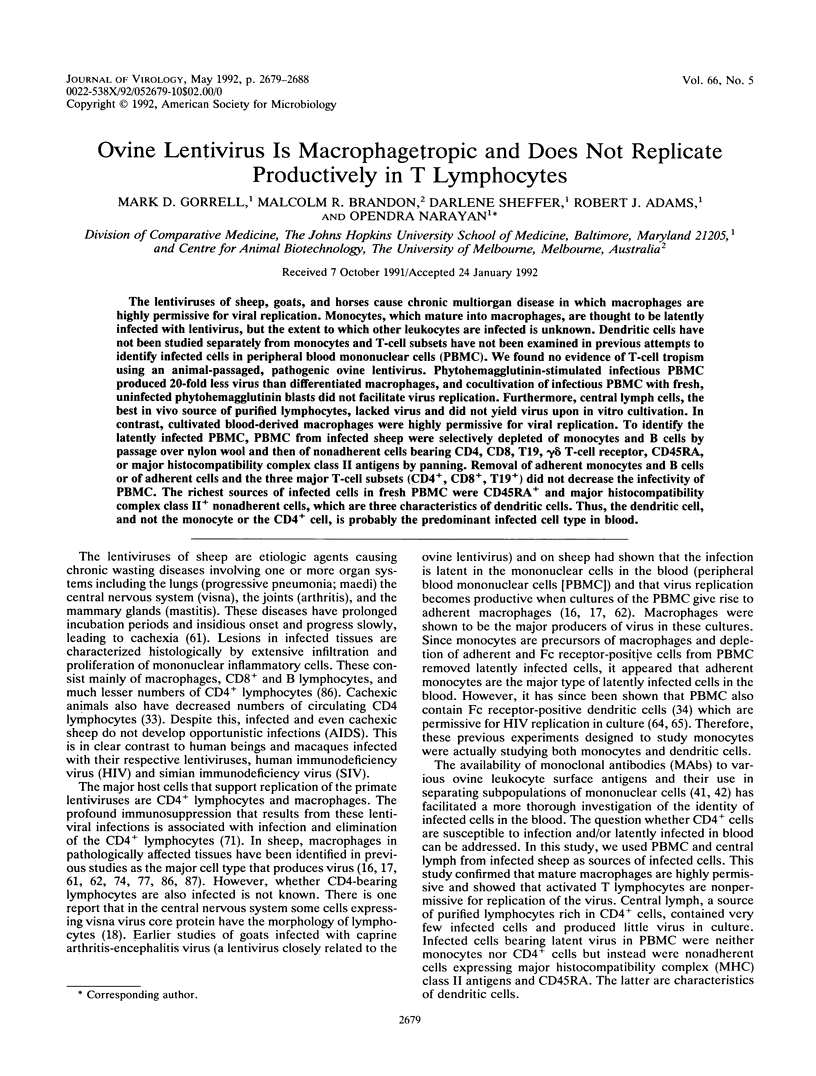
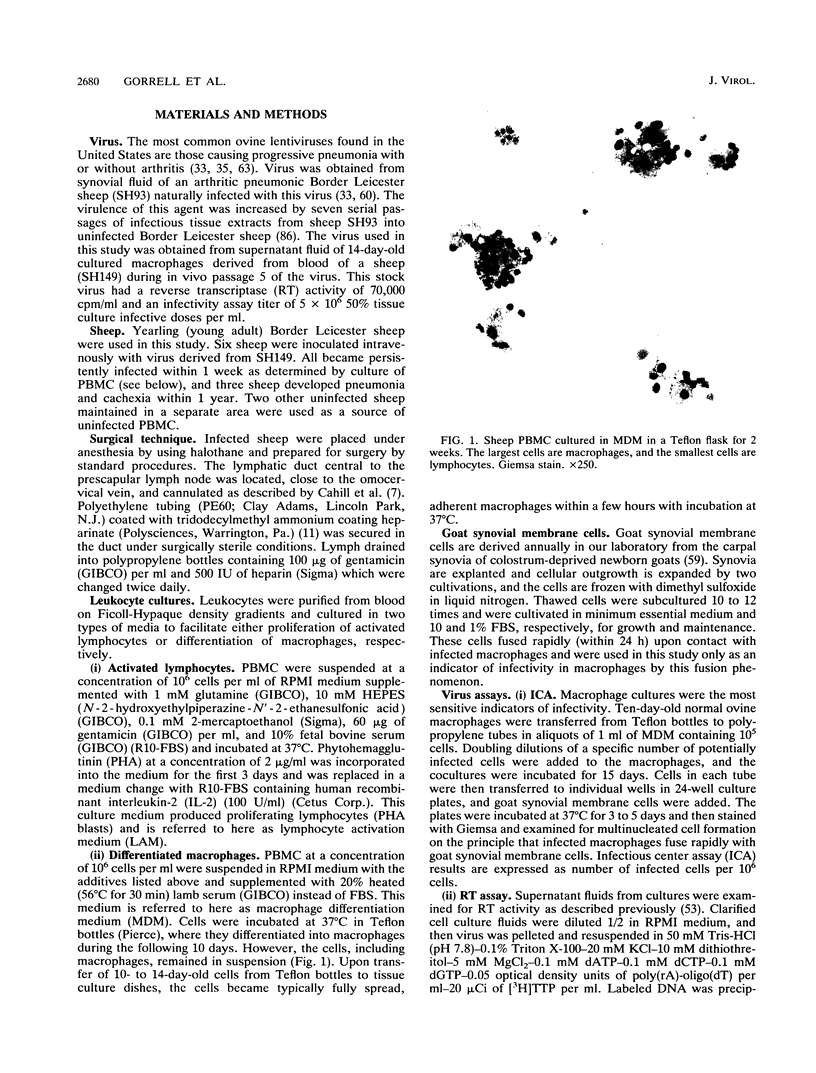
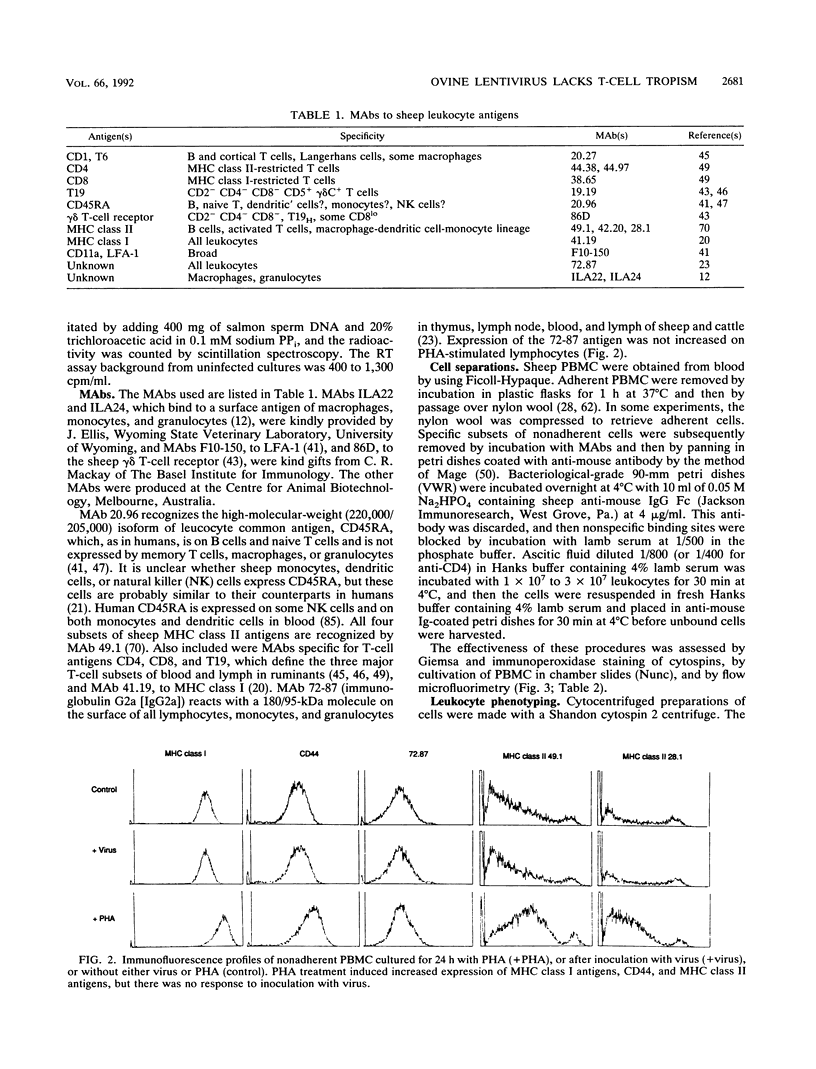
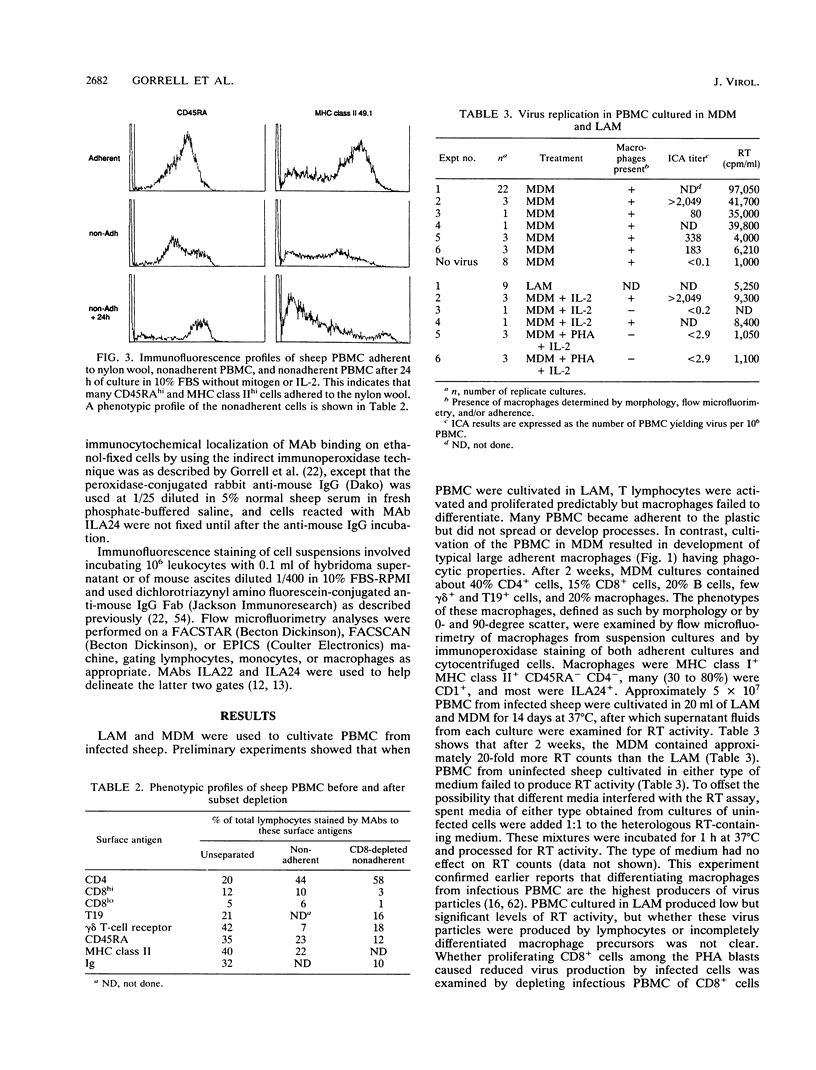
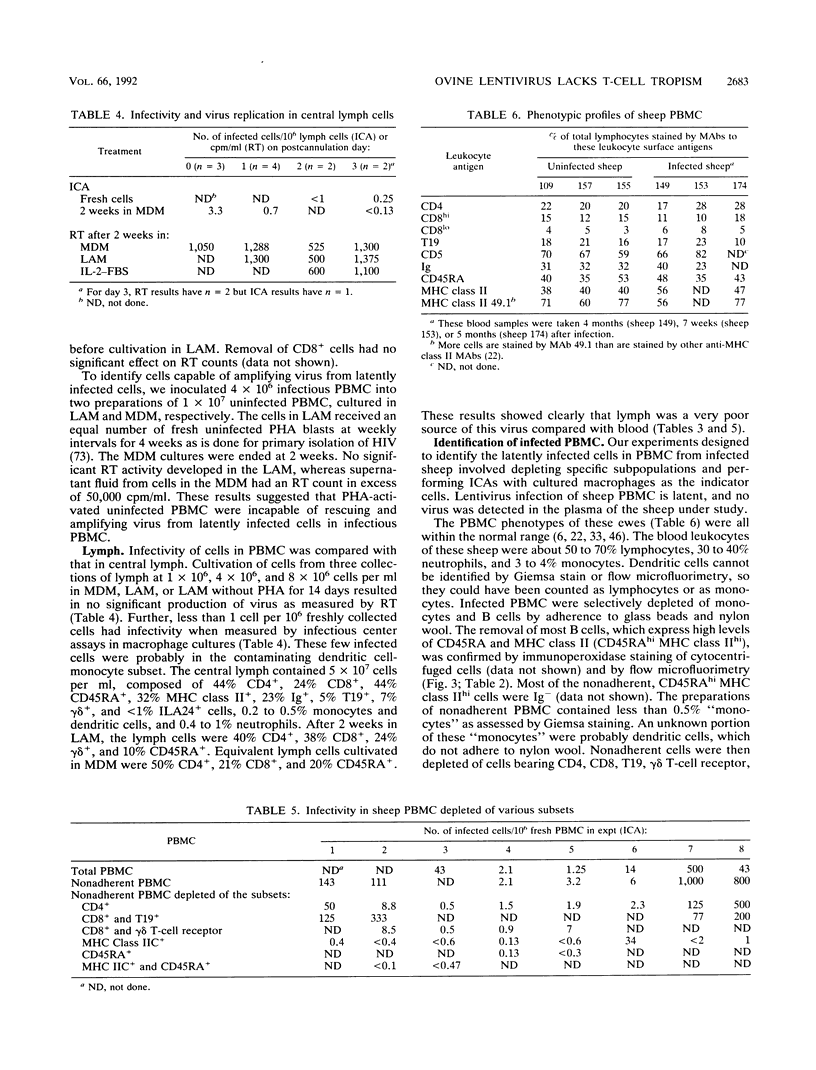
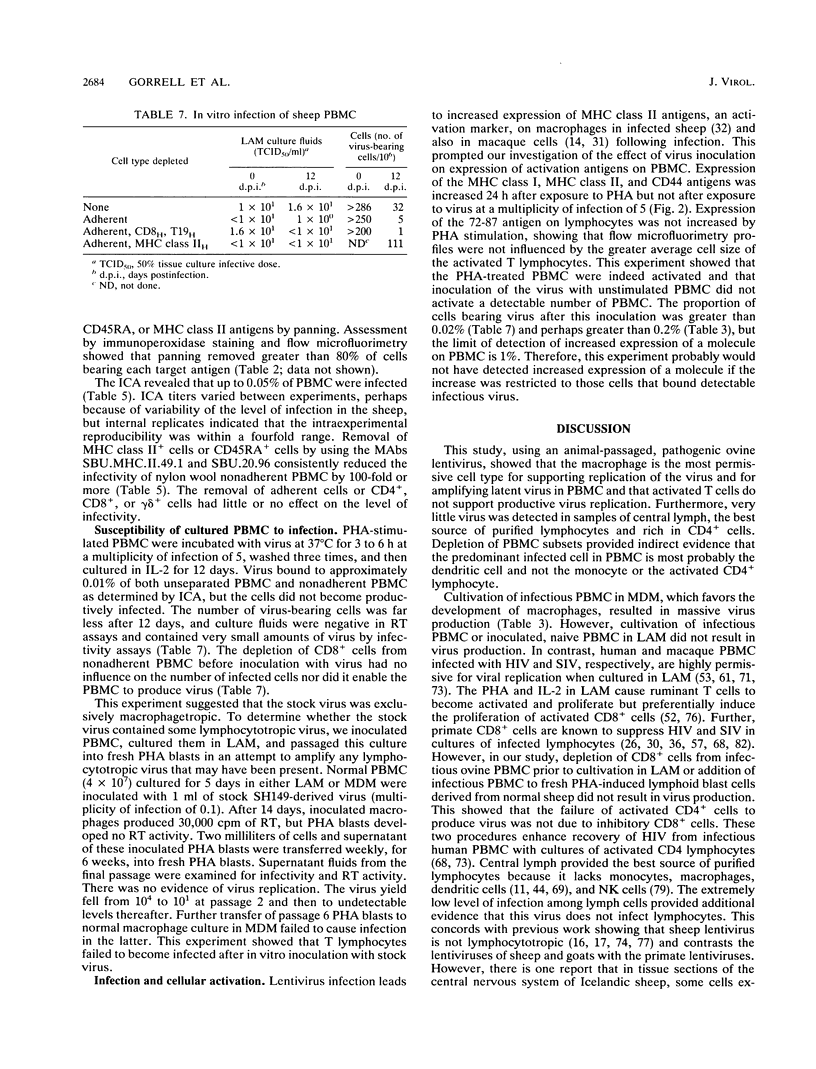
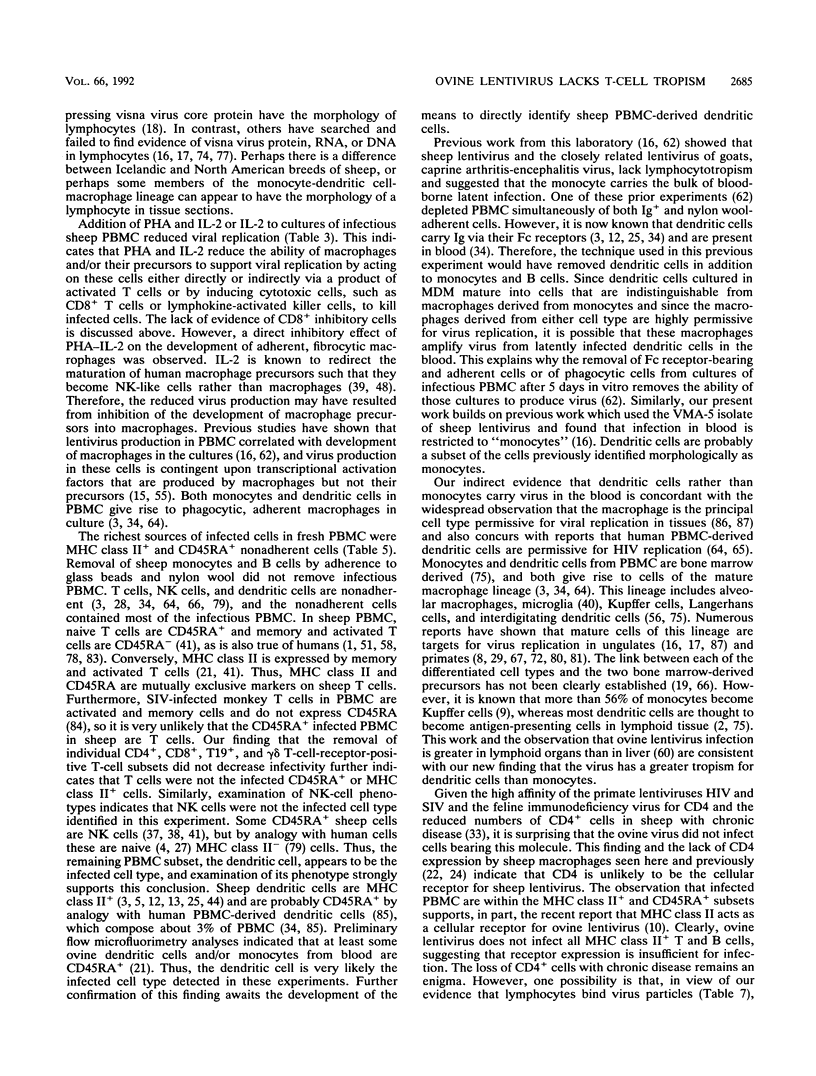
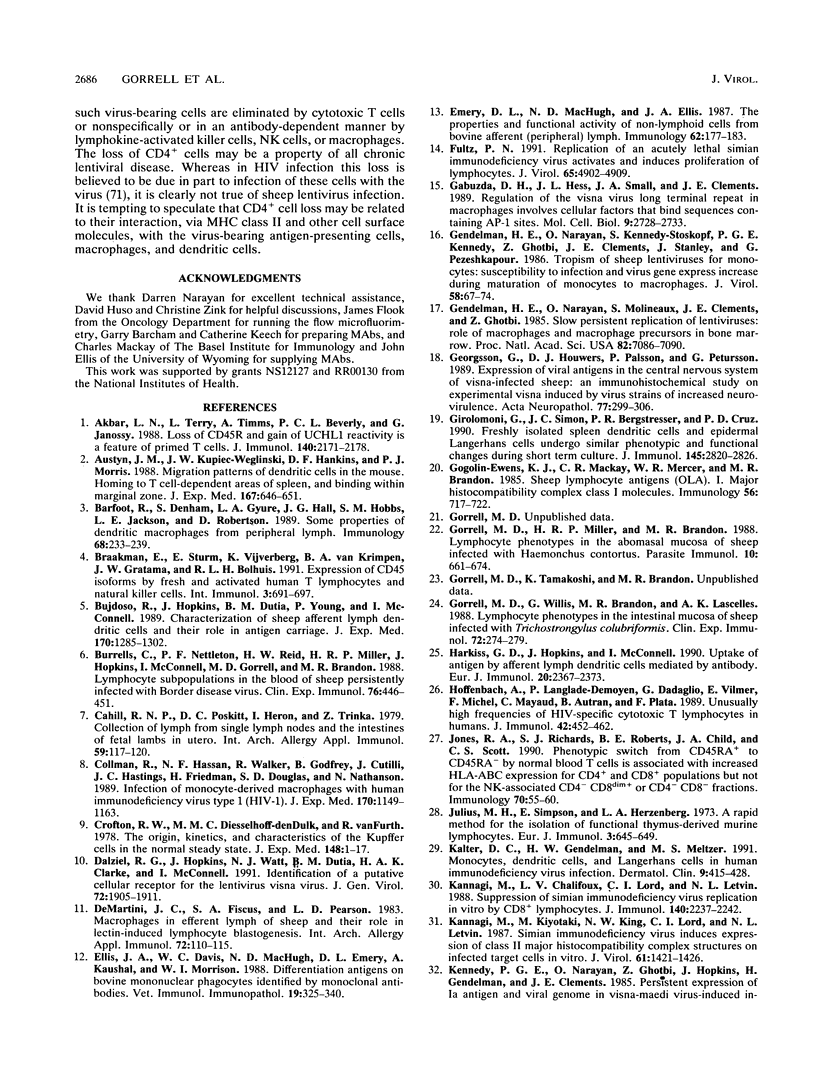
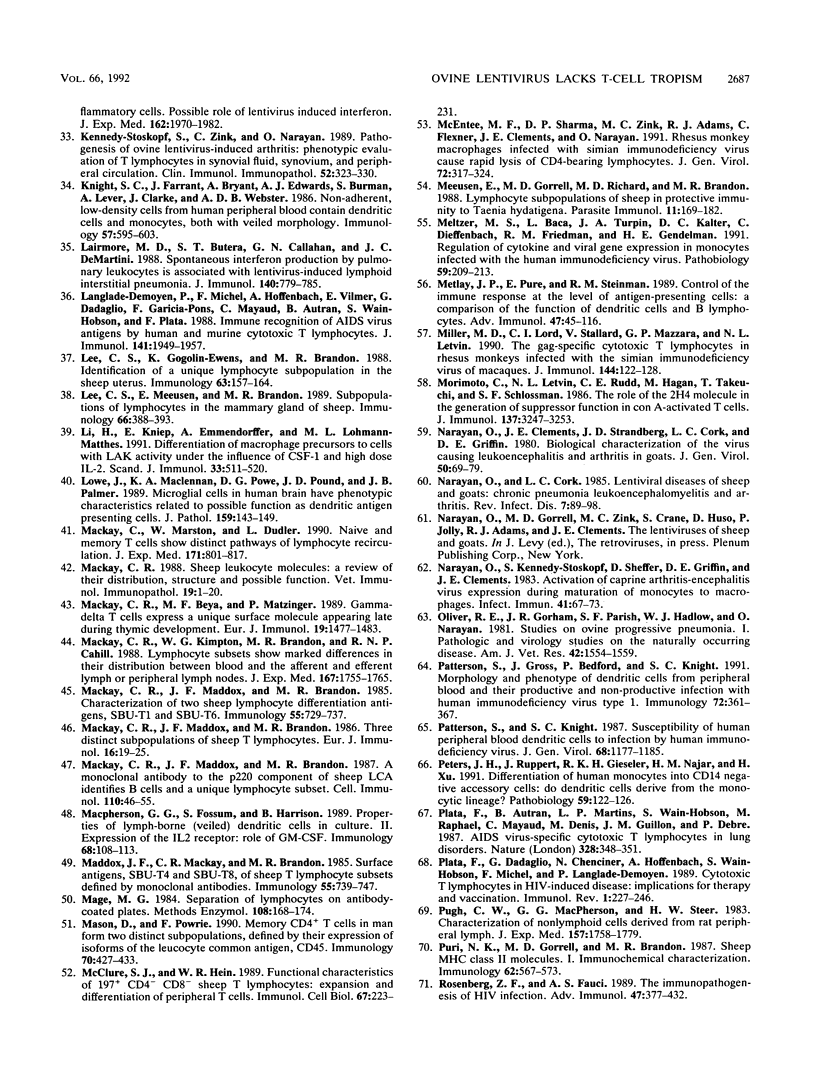
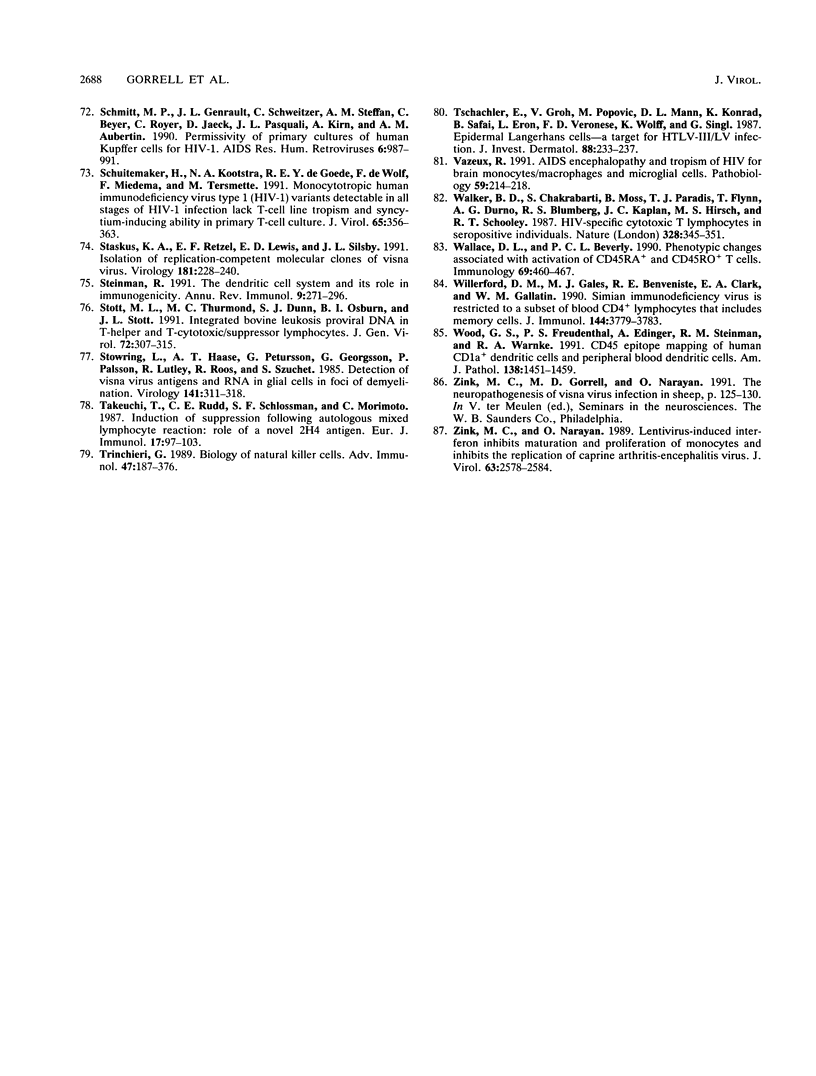
Images in this article
Selected References
These references are in PubMed. This may not be the complete list of references from this article.
- Akbar A. N., Terry L., Timms A., Beverley P. C., Janossy G. Loss of CD45R and gain of UCHL1 reactivity is a feature of primed T cells. J Immunol. 1988 Apr 1;140(7):2171–2178. [PubMed] [Google Scholar]
- Austyn J. M., Kupiec-Weglinski J. W., Hankins D. F., Morris P. J. Migration patterns of dendritic cells in the mouse. Homing to T cell-dependent areas of spleen, and binding within marginal zone. J Exp Med. 1988 Feb 1;167(2):646–651. doi: 10.1084/jem.167.2.646. [DOI] [PMC free article] [PubMed] [Google Scholar]
- Barfoot R., Denham S., Gyure L. A., Hall J. G., Hobbs S. M., Jackson L. E., Robertson D. Some properties of dendritic macrophages from peripheral lymph. Immunology. 1989 Oct;68(2):233–239. [PMC free article] [PubMed] [Google Scholar]
- Braakman E., Sturm E., Vijverberg K., van Krimpen B. A., Gratama J. W., Bolhuis R. L. Expression of CD45 isoforms by fresh and activated human gamma delta T lymphocytes and natural killer cells. Int Immunol. 1991 Jul;3(7):691–697. doi: 10.1093/intimm/3.7.691. [DOI] [PubMed] [Google Scholar]
- Bujdoso R., Hopkins J., Dutia B. M., Young P., McConnell I. Characterization of sheep afferent lymph dendritic cells and their role in antigen carriage. J Exp Med. 1989 Oct 1;170(4):1285–1301. doi: 10.1084/jem.170.4.1285. [DOI] [PMC free article] [PubMed] [Google Scholar]
- Burrells C., Nettleton P. F., Reid H. W., Miller H. R., Hopkins J., McConnell I., Gorrell M. D., Brandon M. R. Lymphocyte subpopulations in the blood of sheep persistently infected with border disease virus. Clin Exp Immunol. 1989 Jun;76(3):446–451. [PMC free article] [PubMed] [Google Scholar]
- Cahill R. N., Poskitt D. C., Heron I., Trnka Z. Collection of lymph from single lymph nodes and the intestines of fetal lambs in utero. Int Arch Allergy Appl Immunol. 1979;59(1):117–120. doi: 10.1159/000232248. [DOI] [PubMed] [Google Scholar]
- Collman R., Hassan N. F., Walker R., Godfrey B., Cutilli J., Hastings J. C., Friedman H., Douglas S. D., Nathanson N. Infection of monocyte-derived macrophages with human immunodeficiency virus type 1 (HIV-1). Monocyte-tropic and lymphocyte-tropic strains of HIV-1 show distinctive patterns of replication in a panel of cell types. J Exp Med. 1989 Oct 1;170(4):1149–1163. doi: 10.1084/jem.170.4.1149. [DOI] [PMC free article] [PubMed] [Google Scholar]
- Crofton R. W., Diesselhoff-den Dulk M. M., van Furth R. The origin, kinetics, and characteristics of the Kupffer cells in the normal steady state. J Exp Med. 1978 Jul 1;148(1):1–17. doi: 10.1084/jem.148.1.1. [DOI] [PMC free article] [PubMed] [Google Scholar]
- Dalziel R. G., Hopkins J., Watt N. J., Dutia B. M., Clarke H. A., McConnell I. Identification of a putative cellular receptor for the lentivirus visna virus. J Gen Virol. 1991 Aug;72(Pt 8):1905–1911. doi: 10.1099/0022-1317-72-8-1905. [DOI] [PubMed] [Google Scholar]
- De Martini J. C., Fiscus S. A., Pearson L. D. Macrophages in efferent lymph of sheep and their role in lectin-induced lymphocyte blastogenesis. Int Arch Allergy Appl Immunol. 1983;72(2):110–115. doi: 10.1159/000234851. [DOI] [PubMed] [Google Scholar]
- Ellis J. A., Davis W. C., MacHugh N. D., Emery D. L., Kaushal A., Morrison W. I. Differentiation antigens on bovine mononuclear phagocytes identified by monoclonal antibodies. Vet Immunol Immunopathol. 1988 Oct;19(3-4):325–340. doi: 10.1016/0165-2427(88)90118-3. [DOI] [PubMed] [Google Scholar]
- Emery D. L., MacHugh N. D., Ellis J. A. The properties and functional activity of non-lymphoid cells from bovine afferent (peripheral) lymph. Immunology. 1987 Oct;62(2):177–183. [PMC free article] [PubMed] [Google Scholar]
- Fultz P. N. Replication of an acutely lethal simian immunodeficiency virus activates and induces proliferation of lymphocytes. J Virol. 1991 Sep;65(9):4902–4909. doi: 10.1128/jvi.65.9.4902-4909.1991. [DOI] [PMC free article] [PubMed] [Google Scholar]
- Gabuzda D. H., Hess J. L., Small J. A., Clements J. E. Regulation of the visna virus long terminal repeat in macrophages involves cellular factors that bind sequences containing AP-1 sites. Mol Cell Biol. 1989 Jun;9(6):2728–2733. doi: 10.1128/mcb.9.6.2728. [DOI] [PMC free article] [PubMed] [Google Scholar]
- Gendelman H. E., Narayan O., Kennedy-Stoskopf S., Kennedy P. G., Ghotbi Z., Clements J. E., Stanley J., Pezeshkpour G. Tropism of sheep lentiviruses for monocytes: susceptibility to infection and virus gene expression increase during maturation of monocytes to macrophages. J Virol. 1986 Apr;58(1):67–74. doi: 10.1128/jvi.58.1.67-74.1986. [DOI] [PMC free article] [PubMed] [Google Scholar]
- Gendelman H. E., Narayan O., Molineaux S., Clements J. E., Ghotbi Z. Slow, persistent replication of lentiviruses: role of tissue macrophages and macrophage precursors in bone marrow. Proc Natl Acad Sci U S A. 1985 Oct;82(20):7086–7090. doi: 10.1073/pnas.82.20.7086. [DOI] [PMC free article] [PubMed] [Google Scholar]
- Georgsson G., Houwers D. J., Pálsson P. A., Pétursson G. Expression of viral antigens in the central nervous system of visna-infected sheep: an immunohistochemical study on experimental visna induced by virus strains of increased neurovirulence. Acta Neuropathol. 1989;77(3):299–306. doi: 10.1007/BF00687582. [DOI] [PubMed] [Google Scholar]
- Girolomoni G., Simon J. C., Bergstresser P. R., Cruz P. D., Jr Freshly isolated spleen dendritic cells and epidermal Langerhans cells undergo similar phenotypic and functional changes during short-term culture. J Immunol. 1990 Nov 1;145(9):2820–2826. [PubMed] [Google Scholar]
- Gogolin-Ewens K. J., Mackay C. R., Mercer W. R., Brandon M. R. Sheep lymphocyte antigens (OLA). I. Major histocompatibility complex class I molecules. Immunology. 1985 Dec;56(4):717–723. [PMC free article] [PubMed] [Google Scholar]
- Gorrell M. D., Miller H. R., Brandon M. R. Lymphocyte phenotypes in the abomasal mucosa of sheep infected with Haemonchus contortus. Parasite Immunol. 1988 Nov;10(6):661–674. doi: 10.1111/j.1365-3024.1988.tb00252.x. [DOI] [PubMed] [Google Scholar]
- Gorrell M. D., Willis G., Brandon M. R., Lascelles A. K. Lymphocyte phenotypes in the intestinal mucosa of sheep infected with Trichostrongylus colubriformis. Clin Exp Immunol. 1988 May;72(2):274–279. [PMC free article] [PubMed] [Google Scholar]
- Harkiss G. D., Hopkins J., McConnell I. Uptake of antigen by afferent lymph dendritic cells mediated by antibody. Eur J Immunol. 1990 Nov;20(11):2367–2373. doi: 10.1002/eji.1830201102. [DOI] [PubMed] [Google Scholar]
- Hoffenbach A., Langlade-Demoyen P., Dadaglio G., Vilmer E., Michel F., Mayaud C., Autran B., Plata F. Unusually high frequencies of HIV-specific cytotoxic T lymphocytes in humans. J Immunol. 1989 Jan 15;142(2):452–462. [PubMed] [Google Scholar]
- Jones R. A., Richards S. J., Roberts B. E., Child J. A., Scott C. S. Phenotypic switch from CD45RA+ to CD45RA- by normal blood T cells is associated with increased HLA-ABC expression for CD4+ and CD8+ populations but not for the NK-associated CD4-CD8dim+ or CD4-CD8- fractions. Immunology. 1990 May;70(1):55–60. [PMC free article] [PubMed] [Google Scholar]
- Julius M. H., Simpson E., Herzenberg L. A. A rapid method for the isolation of functional thymus-derived murine lymphocytes. Eur J Immunol. 1973 Oct;3(10):645–649. doi: 10.1002/eji.1830031011. [DOI] [PubMed] [Google Scholar]
- Kalter D. C., Gendelman H. E., Meltzer M. S. Monocytes, dendritic cells, and Langerhans cells in human immunodeficiency virus infection. Dermatol Clin. 1991 Jul;9(3):415–428. [PubMed] [Google Scholar]
- Kannagi M., Chalifoux L. V., Lord C. I., Letvin N. L. Suppression of simian immunodeficiency virus replication in vitro by CD8+ lymphocytes. J Immunol. 1988 Apr 1;140(7):2237–2242. [PubMed] [Google Scholar]
- Kannagi M., Kiyotaki M., King N. W., Lord C. I., Letvin N. L. Simian immunodeficiency virus induces expression of class II major histocompatibility complex structures on infected target cells in vitro. J Virol. 1987 May;61(5):1421–1426. doi: 10.1128/jvi.61.5.1421-1426.1987. [DOI] [PMC free article] [PubMed] [Google Scholar]
- Kennedy-Stoskopf S., Zink C., Narayan O. Pathogenesis of ovine lentivirus-induced arthritis: phenotypic evaluation of T lymphocytes in synovial fluid, synovium, and peripheral circulation. Clin Immunol Immunopathol. 1989 Aug;52(2):323–330. doi: 10.1016/0090-1229(89)90183-9. [DOI] [PubMed] [Google Scholar]
- Kennedy P. G., Narayan O., Ghotbi Z., Hopkins J., Gendelman H. E., Clements J. E. Persistent expression of Ia antigen and viral genome in visna-maedi virus-induced inflammatory cells. Possible role of lentivirus-induced interferon. J Exp Med. 1985 Dec 1;162(6):1970–1982. doi: 10.1084/jem.162.6.1970. [DOI] [PMC free article] [PubMed] [Google Scholar]
- Knight S. C., Farrant J., Bryant A., Edwards A. J., Burman S., Lever A., Clarke J., Webster A. D. Non-adherent, low-density cells from human peripheral blood contain dendritic cells and monocytes, both with veiled morphology. Immunology. 1986 Apr;57(4):595–603. [PMC free article] [PubMed] [Google Scholar]
- Lairmore M. D., Butera S. T., Callahan G. N., DeMartini J. C. Spontaneous interferon production by pulmonary leukocytes is associated with lentivirus-induced lymphoid interstitial pneumonia. J Immunol. 1988 Feb 1;140(3):779–785. [PubMed] [Google Scholar]
- Langlade-Demoyen P., Michel F., Hoffenbach A., Vilmer E., Dadaglio G., Garicia-Pons F., Mayaud C., Autran B., Wain-Hobson S., Plata F. Immune recognition of AIDS virus antigens by human and murine cytotoxic T lymphocytes. J Immunol. 1988 Sep 15;141(6):1949–1957. [PubMed] [Google Scholar]
- Lee C. S., Gogolin-Ewens K., Brandon M. R. Identification of a unique lymphocyte subpopulation in the sheep uterus. Immunology. 1988 Jan;63(1):157–164. [PMC free article] [PubMed] [Google Scholar]
- Lee C. S., Meeusen E., Brandon M. R. Subpopulations of lymphocytes in the mammary gland of sheep. Immunology. 1989 Mar;66(3):388–393. [PMC free article] [PubMed] [Google Scholar]
- Li H., Kniep E., Emmendörffer A., Lohmann-Matthes M. L. Differentiation of macrophage precursors to cells with LAK activity under the influence of CSF-1 and high dose IL-2. Scand J Immunol. 1991 May;33(5):511–520. doi: 10.1111/j.1365-3083.1991.tb02521.x. [DOI] [PubMed] [Google Scholar]
- Lowe J., MacLennan K. A., Powe D. G., Pound J. D., Palmer J. B. Microglial cells in human brain have phenotypic characteristics related to possible function as dendritic antigen presenting cells. J Pathol. 1989 Oct;159(2):143–149. doi: 10.1002/path.1711590209. [DOI] [PubMed] [Google Scholar]
- MacPherson G. G., Fossum S., Harrison B. Properties of lymph-borne (veiled) dendritic cells in culture. II. Expression of the IL-2 receptor: role of GM-CSF. Immunology. 1989 Sep;68(1):108–113. [PMC free article] [PubMed] [Google Scholar]
- Mackay C. R., Beya M. F., Matzinger P. Gamma/delta T cells express a unique surface molecule appearing late during thymic development. Eur J Immunol. 1989 Aug;19(8):1477–1483. doi: 10.1002/eji.1830190820. [DOI] [PubMed] [Google Scholar]
- Mackay C. R., Kimpton W. G., Brandon M. R., Cahill R. N. Lymphocyte subsets show marked differences in their distribution between blood and the afferent and efferent lymph of peripheral lymph nodes. J Exp Med. 1988 Jun 1;167(6):1755–1765. doi: 10.1084/jem.167.6.1755. [DOI] [PMC free article] [PubMed] [Google Scholar]
- Mackay C. R., Maddox J. F., Brandon M. R. A monoclonal antibody to the p220 component of sheep LCA identifies B cells and a unique lymphocyte subset. Cell Immunol. 1987 Nov;110(1):46–55. doi: 10.1016/0008-8749(87)90100-6. [DOI] [PubMed] [Google Scholar]
- Mackay C. R., Maddox J. F., Brandon M. R. Three distinct subpopulations of sheep T lymphocytes. Eur J Immunol. 1986 Jan;16(1):19–25. doi: 10.1002/eji.1830160105. [DOI] [PubMed] [Google Scholar]
- Mackay C. R., Maddox J. F., Gogolin-Ewens K. J., Brandon M. R. Characterization of two sheep lymphocyte differentiation antigens, SBU-T1 and SBU-T6. Immunology. 1985 Aug;55(4):729–737. [PMC free article] [PubMed] [Google Scholar]
- Mackay C. R., Marston W. L., Dudler L. Naive and memory T cells show distinct pathways of lymphocyte recirculation. J Exp Med. 1990 Mar 1;171(3):801–817. doi: 10.1084/jem.171.3.801. [DOI] [PMC free article] [PubMed] [Google Scholar]
- Mackay C. Sheep leukocyte molecules: a review of their distribution, structure and possible function. Vet Immunol Immunopathol. 1988 Jul;19(1):1–20. doi: 10.1016/0165-2427(88)90042-6. [DOI] [PubMed] [Google Scholar]
- Maddox J. F., Mackay C. R., Brandon M. R. Surface antigens, SBU-T4 and SBU-T8, of sheep T lymphocyte subsets defined by monoclonal antibodies. Immunology. 1985 Aug;55(4):739–748. [PMC free article] [PubMed] [Google Scholar]
- Mason D., Powrie F. Memory CD4+ T cells in man form two distinct subpopulations, defined by their expression of isoforms of the leucocyte common antigen, CD45. Immunology. 1990 Aug;70(4):427–433. [PMC free article] [PubMed] [Google Scholar]
- McClure S. J., Hein W. R. Functional characteristics of 197+ CD4- CD8- sheep T lymphocytes: expansion and differentiation of peripheral T cells. Immunol Cell Biol. 1989 Aug;67(Pt 4):223–231. doi: 10.1038/icb.1989.34. [DOI] [PubMed] [Google Scholar]
- McEntee M. F., Sharma D. P., Zink M. C., Adams R. J., Flexner C., Clements J. E., Narayan O. Rhesus monkey macrophages infected with simian immunodeficiency virus cause rapid lysis of CD4-bearing lymphocytes. J Gen Virol. 1991 Feb;72(Pt 2):317–324. doi: 10.1099/0022-1317-72-2-317. [DOI] [PubMed] [Google Scholar]
- Meeusen E., Gorrell M. D., Rickard M. D., Brandon M. R. Lymphocyte subpopulations of sheep in protective immunity to Taenia hydatigena. Parasite Immunol. 1989 Mar;11(2):169–181. doi: 10.1111/j.1365-3024.1989.tb00657.x. [DOI] [PubMed] [Google Scholar]
- Meltzer M. S., Baca L., Turpin J. A., Kalter D. C., Dieffenbach C., Friedman R. M., Gendelman H. E. Regulation of cytokine and viral gene expression in monocytes infected with the human immunodeficiency virus. Pathobiology. 1991;59(4):209–213. doi: 10.1159/000163647. [DOI] [PubMed] [Google Scholar]
- Metlay J. P., Puré E., Steinman R. M. Control of the immune response at the level of antigen-presenting cells: a comparison of the function of dendritic cells and B lymphocytes. Adv Immunol. 1989;47:45–116. doi: 10.1016/s0065-2776(08)60662-8. [DOI] [PubMed] [Google Scholar]
- Miller M. D., Lord C. I., Stallard V., Mazzara G. P., Letvin N. L. The gag-specific cytotoxic T lymphocytes in rhesus monkeys infected with the simian immunodeficiency virus of macaques. J Immunol. 1990 Jan 1;144(1):122–128. [PubMed] [Google Scholar]
- Morimoto C., Letvin N. L., Rudd C. E., Hagan M., Takeuchi T., Schlossman S. F. The role of the 2H4 molecule in the generation of suppressor function in Con A-activated T cells. J Immunol. 1986 Nov 15;137(10):3247–3253. [PubMed] [Google Scholar]
- Narayan O., Clements J. E., Strandberg J. D., Cork L. C., Griffin D. E. Biological characterization of the virus causing leukoencephalitis and arthritis in goats. J Gen Virol. 1980 Sep;50(1):69–79. doi: 10.1099/0022-1317-50-1-69. [DOI] [PubMed] [Google Scholar]
- Narayan O., Cork L. C. Lentiviral diseases of sheep and goats: chronic pneumonia leukoencephalomyelitis and arthritis. Rev Infect Dis. 1985 Jan-Feb;7(1):89–98. doi: 10.1093/clinids/7.1.89. [DOI] [PubMed] [Google Scholar]
- Narayan O., Kennedy-Stoskopf S., Sheffer D., Griffin D. E., Clements J. E. Activation of caprine arthritis-encephalitis virus expression during maturation of monocytes to macrophages. Infect Immun. 1983 Jul;41(1):67–73. doi: 10.1128/iai.41.1.67-73.1983. [DOI] [PMC free article] [PubMed] [Google Scholar]
- Oliver R. E., Gorham J. R., Parish S. F., Hadlow W. J., Narayan O. Ovine progressive pneumonia: pathologic and virologic studies on the naturally occurring disease. Am J Vet Res. 1981 Sep;42(9):1554–1559. [PubMed] [Google Scholar]
- Patterson S., Gross J., Bedford P., Knight S. C. Morphology and phenotype of dendritic cells from peripheral blood and their productive and non-productive infection with human immunodeficiency virus type 1. Immunology. 1991 Mar;72(3):361–367. [PMC free article] [PubMed] [Google Scholar]
- Patterson S., Knight S. C. Susceptibility of human peripheral blood dendritic cells to infection by human immunodeficiency virus. J Gen Virol. 1987 Apr;68(Pt 4):1177–1181. doi: 10.1099/0022-1317-68-4-1177. [DOI] [PubMed] [Google Scholar]
- Peters J. H., Ruppert J., Gieseler R. K., Najar H. M., Xu H. Differentiation of human monocytes into CD14 negative accessory cells: do dendritic cells derive from the monocytic lineage? Pathobiology. 1991;59(3):122–126. doi: 10.1159/000163628. [DOI] [PubMed] [Google Scholar]
- Plata F., Autran B., Martins L. P., Wain-Hobson S., Raphaël M., Mayaud C., Denis M., Guillon J. M., Debré P. AIDS virus-specific cytotoxic T lymphocytes in lung disorders. Nature. 1987 Jul 23;328(6128):348–351. doi: 10.1038/328348a0. [DOI] [PubMed] [Google Scholar]
- Plata F., Dadaglio G., Chenciner N., Hoffenbach A., Wain-Hobson S., Michel F., Langlade-Demoyen P. Cytotoxic T lymphocytes in HIV-induced disease: implications for therapy and vaccination. Immunodefic Rev. 1989;1(3):227–246. [PubMed] [Google Scholar]
- Pugh C. W., MacPherson G. G., Steer H. W. Characterization of nonlymphoid cells derived from rat peripheral lymph. J Exp Med. 1983 Jun 1;157(6):1758–1779. doi: 10.1084/jem.157.6.1758. [DOI] [PMC free article] [PubMed] [Google Scholar]
- Puri N. K., Gorrell M. D., Brandon M. R. Sheep MHC class II molecules. I. Immunochemical characterization. Immunology. 1987 Dec;62(4):567–573. [PMC free article] [PubMed] [Google Scholar]
- Reisner Y., Sharon N. Fractionation of subpopulations of mouse and human lymphocytes by peanut agglutinin or soybean agglutinin. Methods Enzymol. 1984;108:168–179. doi: 10.1016/s0076-6879(84)08084-8. [DOI] [PubMed] [Google Scholar]
- Rosenberg Z. F., Fauci A. S. The immunopathogenesis of HIV infection. Adv Immunol. 1989;47:377–431. doi: 10.1016/s0065-2776(08)60665-3. [DOI] [PubMed] [Google Scholar]
- Schmitt M. P., Gendrault J. L., Schweitzer C., Steffan A. M., Beyer C., Royer C., Jaeck D., Pasquali J. L., Kirn A., Aubertin A. M. Permissivity of primary cultures of human Kupffer cells for HIV-1. AIDS Res Hum Retroviruses. 1990 Aug;6(8):987–991. doi: 10.1089/aid.1990.6.987. [DOI] [PubMed] [Google Scholar]
- Schuitemaker H., Kootstra N. A., de Goede R. E., de Wolf F., Miedema F., Tersmette M. Monocytotropic human immunodeficiency virus type 1 (HIV-1) variants detectable in all stages of HIV-1 infection lack T-cell line tropism and syncytium-inducing ability in primary T-cell culture. J Virol. 1991 Jan;65(1):356–363. doi: 10.1128/jvi.65.1.356-363.1991. [DOI] [PMC free article] [PubMed] [Google Scholar]
- Staskus K. A., Retzel E. F., Lewis E. D., Silsby J. L., St Cyr S., Rank J. M., Wietgrefe S. W., Haase A. T., Cook R., Fast D. Isolation of replication-competent molecular clones of visna virus. Virology. 1991 Mar;181(1):228–240. doi: 10.1016/0042-6822(91)90488-w. [DOI] [PubMed] [Google Scholar]
- Steinman R. M. The dendritic cell system and its role in immunogenicity. Annu Rev Immunol. 1991;9:271–296. doi: 10.1146/annurev.iy.09.040191.001415. [DOI] [PubMed] [Google Scholar]
- Stott M. L., Thurmond M. C., Dunn S. J., Osburn B. I., Stott J. L. Integrated bovine leukosis proviral DNA in T helper and T cytotoxic/suppressor lymphocytes. J Gen Virol. 1991 Feb;72(Pt 2):307–315. doi: 10.1099/0022-1317-72-2-307. [DOI] [PubMed] [Google Scholar]
- Stowring L., Haase A. T., Petursson G., Georgsson G., Palsson P., Lutley R., Roos R., Szuchet S. Detection of visna virus antigens and RNA in glial cells in foci of demyelination. Virology. 1985 Mar;141(2):311–318. doi: 10.1016/0042-6822(85)90264-8. [DOI] [PubMed] [Google Scholar]
- Takeuchi T., Rudd C. E., Schlossman S. F., Morimoto C. Induction of suppression following autologous mixed lymphocyte reaction; role of a novel 2H4 antigen. Eur J Immunol. 1987 Jan;17(1):97–103. doi: 10.1002/eji.1830170117. [DOI] [PubMed] [Google Scholar]
- Trinchieri G. Biology of natural killer cells. Adv Immunol. 1989;47:187–376. doi: 10.1016/S0065-2776(08)60664-1. [DOI] [PMC free article] [PubMed] [Google Scholar]
- Tschachler E., Groh V., Popovic M., Mann D. L., Konrad K., Safai B., Eron L., diMarzo Veronese F., Wolff K., Stingl G. Epidermal Langerhans cells--a target for HTLV-III/LAV infection. J Invest Dermatol. 1987 Feb;88(2):233–237. doi: 10.1111/1523-1747.ep12525402. [DOI] [PubMed] [Google Scholar]
- Vazeux R. AIDS encephalopathy and tropism of HIV for brain monocytes/macrophages and microglial cells. Pathobiology. 1991;59(4):214–218. doi: 10.1159/000163648. [DOI] [PubMed] [Google Scholar]
- Walker B. D., Chakrabarti S., Moss B., Paradis T. J., Flynn T., Durno A. G., Blumberg R. S., Kaplan J. C., Hirsch M. S., Schooley R. T. HIV-specific cytotoxic T lymphocytes in seropositive individuals. Nature. 1987 Jul 23;328(6128):345–348. doi: 10.1038/328345a0. [DOI] [PubMed] [Google Scholar]
- Wallace D. L., Beverley P. C. Phenotypic changes associated with activation of CD45RA+ and CD45RO+ T cells. Immunology. 1990 Mar;69(3):460–467. [PMC free article] [PubMed] [Google Scholar]
- Willerford D. M., Gale M. J., Jr, Benveniste R. E., Clark E. A., Gallatin W. M. Simian immunodeficiency virus is restricted to a subset of blood CD4+ lymphocytes that includes memory cells. J Immunol. 1990 May 15;144(10):3779–3783. [PubMed] [Google Scholar]
- Wood G. S., Freudenthal P. S., Edinger A., Steinman R. M., Warnke R. A. CD45 epitope mapping of human CD1a+ dendritic cells and peripheral blood dendritic cells. Am J Pathol. 1991 Jun;138(6):1451–1459. [PMC free article] [PubMed] [Google Scholar]
- Zink M. C., Narayan O. Lentivirus-induced interferon inhibits maturation and proliferation of monocytes and restricts the replication of caprine arthritis-encephalitis virus. J Virol. 1989 Jun;63(6):2578–2584. doi: 10.1128/jvi.63.6.2578-2584.1989. [DOI] [PMC free article] [PubMed] [Google Scholar]



